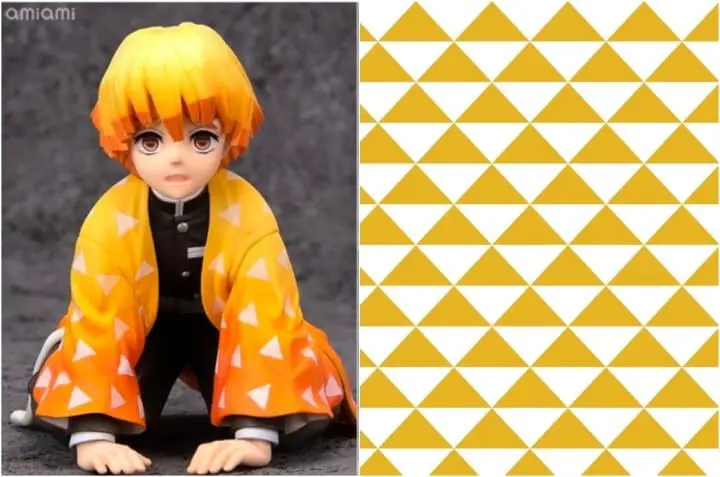Demon Slayer: Hidden Meanings of the Characters' Kimono Patterns

Did you know the patterns on the kimonos worn by Demon Slayer characters have hidden, thematic meanings? Read on to learn about these traditional Japanese patterns!
Demon Slayer: Traditional Kimono Patterns and Hidden Themes
The hit anime Demon Slayer is set in the early twentieth-century Japan. However, the kimono and attire worn by characters like Tanjiro, Zenitsu, Nezuko, and Inosuke aren't just historical items; their designs and patterns have been used in Japan for many centuries and are still popular and significant today.
The characters' kimono patterns are also the inspiration behind some of the show's most popular product designs. These traditional patterns, called “wagara” or “Japanese patterns,” have specific names and meanings. Let’s take a look at these characters, and the themes hidden in their outfits!
Tanjiro's Ichimatsu Checkered Pattern

Pictures courtesy of PR TIMES (Japanese), The Tokyo Organising Committee of the Olympic and Paralympic Games, ULOCO
Tanjiro Kamado wears a kimono with a black-and-green ichimatsu pattern. This checkered pattern is a combination of square or rectangular shapes in alternating colors, similar to a Go (Japanese chess) board.
The pattern became known as the "ichimatsu pattern" after being popularized by kabuki actor Sanogawa Ichimatsu (1722–1762) who wore striking white and blue checked trousers. This term continues to be used today.
Ichimatsu patterns represent longevity, thriving in business, and both personal and familial prosperity.
The Tokyo 2020 Olympic and Paralympic Games also take inspiration from the ichimatsu pattern in their logos. Different countries, cultures, and ideologies are represented with three quadrilateral shapes. Combined, these shapes convey a message of “unity in diversity” and transform into a composite ichimatsu pattern design.
Nezuko's Asanoha Hemp Leaf Pattern

Pictures courtesy of PR TIMES (Japanese), ULOCO
The kimono worn by Nezuko—Tanjiro’s younger sister—features a nature inspired pattern. She wears a kimono with an asanoha (hemp leaf) pattern and an ichimatsu-patterned sash.
The hemp leaf pattern is one of the most popular traditional patterns for kimonos. It was inspired by the shape of overlapping hemp leaves. This pattern can often be seen in Buddhist art and statues. It was also popular in kabuki stage costumes and woodblock prints during the Edo Period (1603-1868).
Babies and children were often given clothing sewn from asanoha textiles, since hemp leaves were known to be durable and fast-growing. It was believed that wearing clothing with hemp leaf patterns would ward off misfortune and help the child grow strong and healthy.
Zenitsu's Urokomon Scale Pattern

Pictures courtesy of PR TIMES (Japanese), ULOCO
Zenitsu Agatsuma, another popular character, also wears a pattern inspired by nature. This modified version of the urokomon (scale) pattern combines equilateral, overlapping triangles. The pattern is called urokomon because the triangles resemble the scales (uroko) found on snakes, fish, and dragons.
Historically, earthenware with this continuous triangle pattern was used as burial goods that would protect the deceased in the afterlife. It was believed that the pattern had the power to protect against evil and curses, which led to its use on armor and weapons.
During the Muromachi Period (1336-1573), the scale pattern could also be seen in Noh theater, on the costumes of actors playing snakes or vengeful female demons. In the Edo Period (1603-1868), the pattern was associated with molting snakes and butterflies and came to symbolize rebirth and escaping from misfortune.
The scale pattern is also associated with prayers for safety at sea.
Yagasuri Arrow and Seigaiha Wave Patterns

Pictures courtesy of ULOCO
Yagasuri is a traditional pattern that depicts arrow fletching. This pattern is often used on wedding kimonos, in hopes that the bride will fly from her parents' home successfully. This comes from a Japanese saying that, once an arrow is shot, it never returns.
Yagasuri clothing has been popular with young women since the Meiji Period (1868-1912). Today, it's often seen in kimonos worn by young women at their university graduations!
Seigaiha is a pattern made from overlapping semicircles creating a wave-like, geometric design. It is one of the most common traditional Japanese patterns; the endless waves symbolize everlasting happiness and peace.
Discover the Deeper Side to Anime!
Were you surprised by the meanings behind these traditional Japanese patterns? We can all enjoy Japan’s traditional culture thanks to “Demon Slayer.”
These traditional patterns are considered to be very auspicious; that is why they are found not only on clothing but are also used as motifs on daily goods. The next time you watch your favorite anime, take a close look at the traditional patterns that appear and consider what meanings they might hold.
Wouldn’t you like to pick out your favorite pattern as a souvenir to bring home from a trip to Japan?
Main image created using Kimono Patterns by ULOCO
For those already studying, we recommend taking online conversation lessons with CafeTalk (1,000 yen coupon included).
*This article is an edited version of a manga article originally published on MATCHA Traditional Chinese.
[雨木 / Rainwood]http://facebook.com/Rainwood.art 是一個愛畫畫的人,喜歡畫女孩與花草。


























![[2026] Family Winter Trip to Suzuka Circuit! – For Both Day trips and Overnight Stays!](https://resources.matcha-jp.com/resize/720x2000/2025/12/26-254097.webp)
![[Northern Okinawa] 4 Recommended Cosmos Fields in Okinawa | Sunflowers and Cherry Blossoms in the Same Season!](https://resources.matcha-jp.com/resize/720x2000/2024/08/12-192028.webp)


